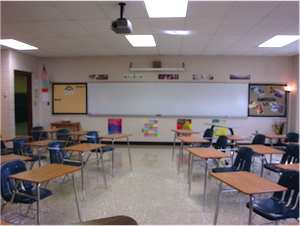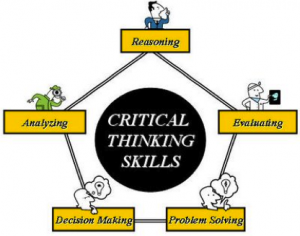Time for a Mid-Year Check In
A MiddleWeb Blog
The winter break is over and the rhythms of school life have resumed. It’s the perfect moment to do a mid-year check in.
With half of this school year behind us (so hard to believe!), and another half of the school year ahead (so exciting!), it is a good time to reevaluate the procedures and structures that are in place in our inclusion classrooms. It’s important to reevaluate our procedures, so that we can make any necessary changes that are in our control.
Classroom Management: Reality Check
When it comes to effective co-teaching, flexibility is the key. Yet a certain amount of structure must be in place to keep the organization solid. So there you have it. It’s simple: a balance of flexibility with structure.
But it’s not just a balance with each side pulling against the weight of the other. Each component must weave naturally within the process of the other to create an effectively managed classroom. Maybe the right metaphor is “a balance of matched threads throughout the weave.”
So how is this naturally woven balance created? The short answers are “over time” and “with determined focus and incredible patience.” In any co-teaching classroom, here are some things to check:
The Physical Set-Up: Are students desks arranged in ways that are conducive to effective instruction? Also, we must make sure that the students with IEPs are included, not integrated. If they are “integrated” (this should be avoided) the students with IEPs are all seated next to each other—together, but still separate. When they are “included” (the way it should be) the students with IEPs are seated strategically amongst their general education peers.

There are other options that encourage students to share their thinking out loud and learn so much from one another. As we reach this half-way mark into the school year, think about how you and your co-teachers are setting up your classrooms. One of my co-teachers decided to change from traditional linear rows to stadium seating where the rows are in an arc shape. The students can now see each other as we engage in class discussions.
We make time to allow students to push their desks together when we want them to think-pair-share. And other times, the desks are arranged in groups of four to five, allowing students in each group to have time to problem solve and work together. Of course, there are also times when linear rows are fine.
Classroom Procedures: Is your class routine one that your co-teacher, all of the students, and you are comfortable with? Is it working? Are any updates needed? Are your routines predictable enough to help students to be independent, yet crazy enough to spark students to wonder and be excited about what the class will do next?
Also, is your behavior management plan working? This is the time of year to evaluate what is in place and then tweak as necessary. No need to wait for next year’s students to make some positive changes that you think of now.
Student Engagement: Do you and your co-teacher hand out the fish? Or do you make your students go fishing? Typically when students are actively involved in the learning process, they are engaged. If you are offering meaningful questions that make students think, and you are requiring students to generate their own questions and seek answers, then you are helping your students to develop valuable life-long learning habits.

Student engagement in the co-taught classroom is a topic that I will delve more deeply into in a future post. For now I’ll leave you with a blog post that expresses my own thinking about student engagement in general. Check it out; hopefully, it will spark some honest reflecting for you and your co-teacher(s): The Problem with Student Engagement is written by Canadian teacher and teaching coach Shelley Wright.
Our responsibility to engage our students — all students — lies heavily upon us, considering what we are asking them to do. Just think about it.
Are you and your co-teacher sharing the responsibility of teaching? More specifically, does each of you have a significant role during the planning, instructional, and assessment phases of teaching? If so, great! Please consider sharing your experience here. If not, do not worry, you are far from alone. This is also a good place to share your frustration. Just add your voice to the comments below, so that we can get some solution-seeking minds together for a productive discussion.
Also, to further spark your voice, please check out these wise words from Anne Benninghof.
She sensibly states:
“Co-teaching isn’t taking turns — it’s teaching together.”
I feel like standing up tall, high on the top of a soapbox, and shouting that out for all to hear. My own situation is probably not too far off from so many of you. I truly appreciate and enjoy working with all of my co-teachers.

I am finding (once again) that changing mindsets about our shared roles takes lots of time and patience. And along my journey, in the midst of this change, I am making sure that I notice and enjoy the small positive baby steps I take with my colleagues each day.
We’re half way home. Please share how things are going with you at this milepost in the school year. What’s going well? What changes would you like to make? Let’s search for some solutions together…




































My colleague and I began co-teaching this year and we are really enjoying it. However, we are general ed teachers (SS/ENG) in a learning environment that does not incorporate “Inclusion”. We are searching for more co-teaching resources and teachers who do the same, but are not a part of an Inclusion classroom. Thanks!!!
Thanks for sharing, mrlchock. We’d love to hear more about your team teaching experience for this school year. What grade do you teach? We hope the resources we’ve shared so far (check out all of our posts) are helpful to you. If there are specific resources you are looking for, let us know. Perhaps we or our readers can brainstorm ideas. Enjoy!
I only saw the reply 7 months later! Oops! I teach 8th grade, English at an Independent school in Honolulu, Hawaii. My co-teacher is technically the Social Studies teacher (U.S. History), but we decided to co-teach last school year in order to better utilize the open-learning environment (No walls!) that our new middle school bldg provided us.
Personally, I believe it was the best decision we made. Students are more engaged, and they each connect with us in different ways. Being able to support each other’s instruction and make technically — two curriculums, one — has shown our students that “school subjects” do not exist without each other when they leave the classroom.
We are co-teaching rookies though, so reading this blog, finding more resources, and connecting to those with similar experiences is essential!
Hi Mandy! It’s never too late to reply–thanks for continuing the conversation. Through your experiences, it sounds like you have learned so much about what it takes to effectively co-teach. As you come across other great resources–please share! Also, I’ve launched a chat on Twitter all about co-teaching–please join the discussion using #coteachat. Next chat is tomorrow 8/13 at 8-8:45 ET. Tomorrow’s topic is about 1st week plans to set the tone for a successful year.
I hope you continue to share your insights at this blog–I’d love to continue our conversation throughout the year. So much to learn from each other!
All the best!
Hi,
I am in a co-teaching relationship, where we are both primary school generalist teachers. My partner is in a leadership role which means that she is taken off class a lot. What do you recommend to do when a teacher is being relieved from class regularly?
When it is scheduled release it’s easier to come up with a plan, however it is normally unscheduled release with an unknown teacher.
Would appreciate your advice
Hi, Laura, this is such a common frustration (sadly!). As you know, there is not one quick fix to solve this; however, there are some ways for you to maintain a solution seeking mindset. Two thoughts that come to mind off the top:
1. Keep communications open with administrators. Keep them informed about how this situation is adversely affecting the learning environment. Share what is working as well as specific frustrations. Be sure to focus on solutions. Keep track of actions taken–and what is working. Re-channel frustrations into manageable steps (no matter how small!). Just keep conversations going–seek administrative support–and keep conversations consistent and focused on what is working and what action steps may be taken in future.
2. Speak with your co-teacher. Come up with a plan for those predictably unpredictable unscheduled release times. Put the plan in writing, so the unknown teacher has a “cheat sheet” of sorts to review and follow–this will at least free you up with the hope that this unknown person jumps right into the mix.
On a positive note…I am so happy to hear that there is a sub for when your co-teacher is released to other responsibilities. You can imagine the horror of one co-teacher being released without a sub in place with the other co-teacher!
What do you think? Does any or all parts of my response resonate or spark? Thank you so much for sharing!
All the best!
-Elizabeth